La Bahio of Sampeyre and the Carlavee of Varallo exemplify how the carnival ritual, through the deliberate alteration of time, space and even the physiological rhythms and identity of the participants, can induce completely peculiar experiences. This is an aspect ignored by much academic research but which needs to be explored further if one wishes to understand the profound meaning of Carnival.
di Lorenzo Maria Colombo
The earth dances the dance of Macabré, it seems to me at times that the Danube is crossed by boats full of madmen heading towards a dark place.
Umberto Eco, The Name of The rose
THE (MIOPICAL) LOOK OF RESEARCH
To study a single anthropological fact, let's say a carnival party, there are, as we know, many possible approaches, which differ depending on the particular specialization of the observer: the historian will tend to base his research on the possibility of recovering archival documents, the ethnologist will lean towards comparison with similar traditions belonging to other cultures, the linguist will focus on the use of dialect, vernacular or particular communication codes in the context of the event itself and so on. These are, of course, absolutely legitimate approaches which, by integrating with each other, can contribute substantially to increasing our knowledge.
However, our impression is that both at an academic level and in the investigations carried out by that broad and difficult to define category that we indicate with the term "local scholars", there is a tendency to favor some cognitive paths over others. Among the most neglected perspectives, when speaking of manifestations of a ritual nature, there is the one that puts the experience of the individual participant in the foreground, the direct description of the experience on both a psychological and physical level; certainly due to the objective difficulty of conducting research in this sense, but also perhaps to a certain influence that the Anglo-Saxon academic world, notoriously inclined to give priority to the objective and quantifiable data of the so-called "hard" sciences, also exercises in the field of humanistic studies. Which, unfortunately, risks precluding views of great interest, capable of shedding more light on the rituals, customs, behaviors and formulaic apparatuses of our cultural tradition.
Piercarlo Grimaldi, following Leroi-Gourhan's lesson, had already underlined how the very structure of the carnival rite implements a series of behaviors which, by reversing the usual rhythms of everyday life and acting at a perceptive, psycho-physiological and neurological level, can induce a state of alteration in the participant's consciousness; and it is precisely through this type of experiential sharing that celebrations, which have the function of marking the rhythmic passage of time, they locate themselves outside of time on a level that is perceived and experienced, even before being understood intellectually, as supra-temporal. To better clarify what we mean, we will take as a practical example two of the most popular Piedmontese carnivals in the Alps, the Bahio of Sampeyre (CN) and the Carlavee of Varallo Sesia (VC), focusing in particular on the day of See you Easter Monday which constitutes the opening moment.
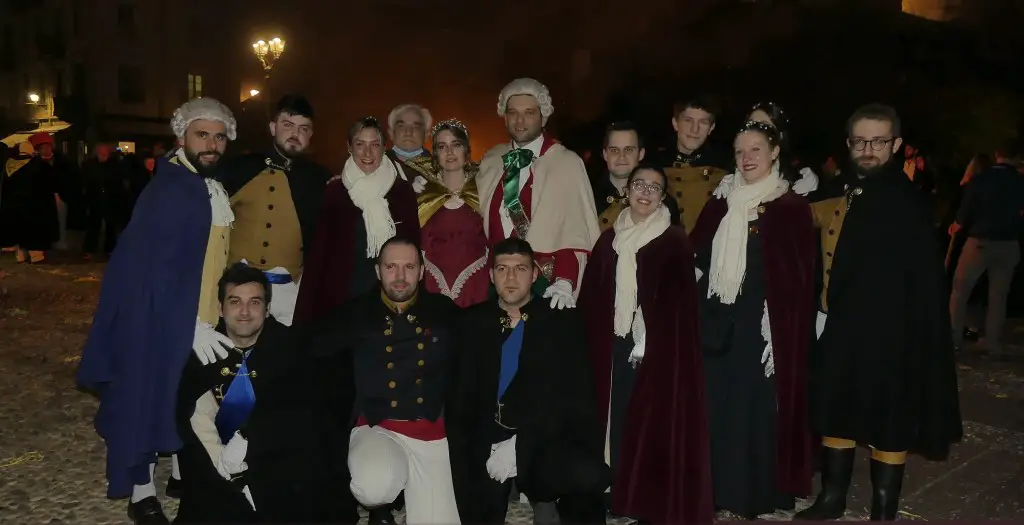
A SPRING WAR
La Bahio (abbey, militia, male association) of Sampeyre, in Val Varaita, is a tradition implemented every five years which would start from a historical event that occurred around the year one thousand: the expulsion by the local militias of the Saracen pirates who came up from Liguria and the French Riviera to plunder the upper Piedmontese valleys. In reality the event has very few features that recall a real historical re-enactment: the costumes worn by the over three hundred characters have nothing medieval about them, and range from knee-length culottes and 700th century feluccas to swallowtail jackets and to the most typical cylinders of the nineteenth century, in that atmosphere of anachronism (but it would perhaps be more correct to speak of a-chronism, or a "time out of time") which is one of the most incisive aspects of the carnival.
A remarkable feature of the costumes are the floral decorations made with precious silk ribbons called bindel, which each family once kept in their chests, lying flat to prevent them from breaking, and women wove according to precise codes on the occasion of particular events such as weddings or baptisms. The use of this type of decoration highlights how the event is grafted, under the pretext of remembering a war episode, onto a tradition that is most likely much older linked to the spring fertility rites.
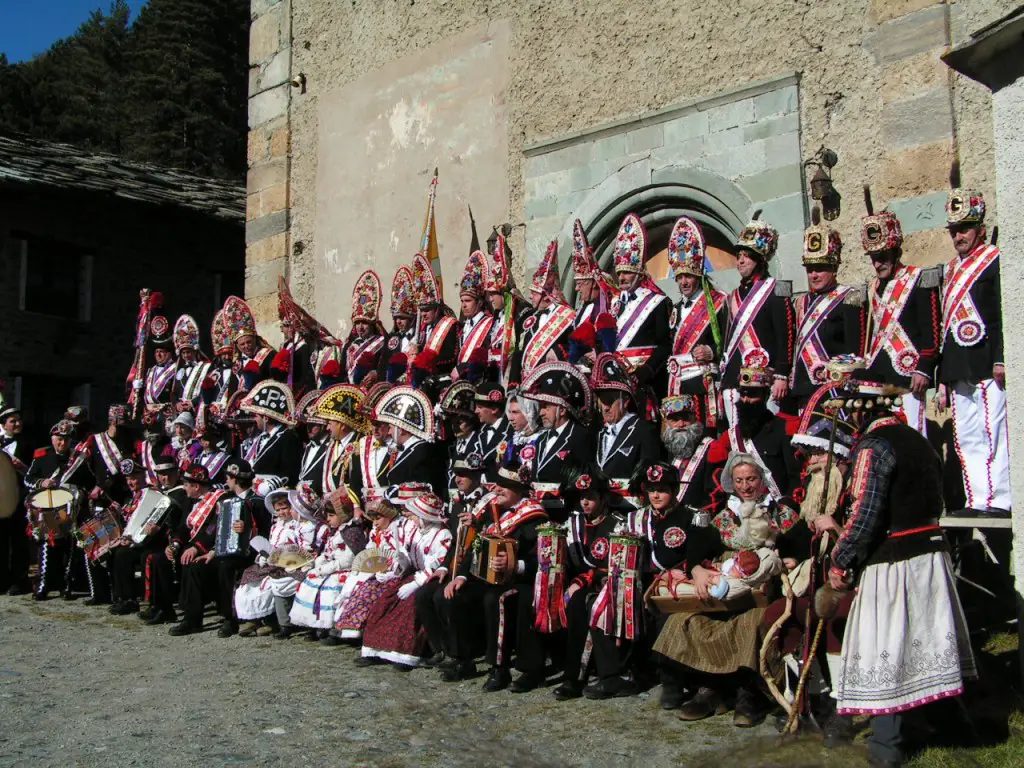
The inhabitants of the Sampeyre area and the hamlets of Calchesio, Rore and Villar participate in the rite, each with their own carnival militia; the Sant'Anna hamlet marches with the Calchesio group, while the inhabitants of Becetto (whose militia was apparently suppressed due to serious public order problems) join the concentric group. The ritual complex officially opens on January 6th when the young people, at the exit of the solemn mass of the Epiphany, enter the square and, shouting loudly and accompanied by drums, accordions, cowbells and improvised musical instruments, ask for the establishment of the Bahio. In the midst of this "ritual din" the group goes under the houses of the Abà that is, the leaders of the militia, who have the burden, including economic, of organizing the parades (in reality today it is the banks, savings banks and local authorities that provide the money for this event, which has important repercussions on the tourist economy of the area). At the display of militia banners outside the windows of the Abà This is followed by a series of formal meetings between the hierarchs, who assign the roles and ensure the actual availability of material and human resources to set up the processions, while the women have the task of preparing the costumes. This is, let us point out, one of the very rare moments of participation by the female gender: practically all the roles within the Bahiò, including the female ones, are in fact played by male actors.
The actual parades begin on the two Sundays preceding the carnival week, with the actors of the various militias marching to the roll of drums and meeting on the borders of their respective areas of residence, exchanging the military salute by crossing their swords. The participants in the parade proceed with order and at a rigid military pace, with the exception of theHarlequin: this is a character who can break up the procession and interact with the spectators by waving a stick from which a stuffed mouse or squirrel is hanging, formally to prevent them from hindering the actors but in reality to give life to small comic skits with the participation of the bystanders, a bit like the Issohadores during the Mamoiada carnival (NU), in Sardinia. This Harlequin, in any case, made of animal fur and the hat from which snail shells hang, recalls more the figure of the Wild Man of many mountain traditions and legends.

The militia parades stop dozens of times during the day at refreshment points set up by the taverns or by the owners of private houses overlooking the street. At each stop there are barricades made of tree trunks, representing the barriers that the fleeing Saracens erected to slow down the pursuit of the winners; they are cut down with axes by the bearded men sapper, corresponding to the sappers of the old Napoleonic army and also present in another famous northern Italian carnival, that of Schignano (CO). The splinters of the wooden trunks are used by the sapeurs as an object of exchange at the taverns in order to drink for free; it can also happen that someone tries to steal a bindel or another element of the actors' costume, or to physically kidnap the character of theespouzo (bride) always obviously played by a man. Whoever suffers theft must chase and capture the thief\kidnapper before he manages to take refuge in a tavern: if this happens the thief will pay for the drink, otherwise the opposite will happen.

The highlight of the ritual is Shrove Thursday: in the morning the fractional militias descend in concentricity for the dances in the town square, which continue until mid-afternoon. Then each procession returns to its home area for the trial of the treasurers, guilty of attempting to escape with the cash; typical figure of the carnival scapegoat who takes upon himself all the ills of the community, the tezourie, pale with fear (his face is purposely smeared with flour) appears in front of the judge dressed in black, and together they stage a farcical trial that can be recited in both Italian and Occitan. The trial ends with the death sentence of the accused, but the sentence is not always implemented: in concentric Sampeyre and Rore two figures dressed in white can intervene, the fie de marié (marriageable girls, this time played by real women) who implore pardon for the condemned man, while in Calchesio and Villar the treasurer is shot by grenades (grenadiers). In the case of Villar it happened in the past that the treasurer was "resurrected" thanks to a generous serving of wine in a nearby tavern, just as happens in other Piedmontese carnivals: we cite as an example the death and resurrection of theHarlequin which concludes the Bal do Saber of Bagnasco, also in the Cuneo area.
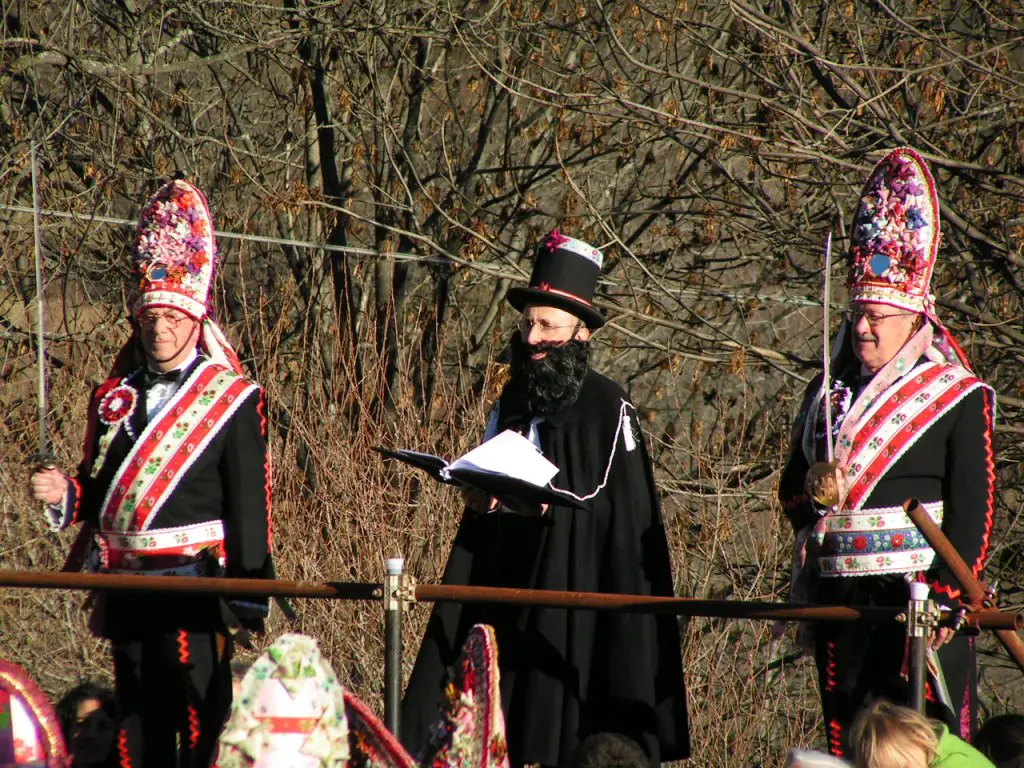
The process is finished the party enters its liveliest phase with a long night vigil which, between dancing and drinking, often continues until the following morning. During the vigil, at the stroke of midnight, the names of the leaders who five years later will have the task of organizing a new Bahio.
“BURN THE OLD WOMAN!”
The carnival of Varallo, the capital of Val Sesia, officially opens on the evening of January 5th with the Great bal d'la Veggia (Grand Dance of the Old Woman); Masked groups from all over the valley participate, for whom the event represents the first official occasion of the year in which they can wear the costumes they cast off at the end of the previous year's carnival. Also in this case the costumes, colorful and sometimes embellished with floral motifs, recall spring; over the costume, when one is outside, a heavy plain-coloured cloak is usually worn, generally black or dark in colour, on which the owner pins the small trinkets that are distributed at every vigil or Carnival event in the valley, so that at a glance it is possible to understand how long the performer of the mask has been part of the rather exclusive environment of the carnival.
Unlike what happens in Sampeyre, males and females participate indifferently in the Valsesian carnivals, with a rigid distinction of roles between the two sexes (king, queen, guard soldier, damsel, concubine, etc.) which is also reflected in the style of the costumes. An exception is a group of characters who appear only and exclusively in Varallo in the first two days of Carnival, or the See you Easter Monday and her family consisting of her husband Veggiu Bacuc (Old Bacucco) and very prosperous nanny who has the task of looking after Marcantonio Carlavèe, king of the carnival that is being born represented by a doll. Both female roles are played by men, but the identity of the actor playing the See (who must always be from Varallo) is kept strictly secret and at the time of the official presentation of the masks, around midnight between January 5th and 6th, she appears with her face covered by a shawl so as not to be recognized.
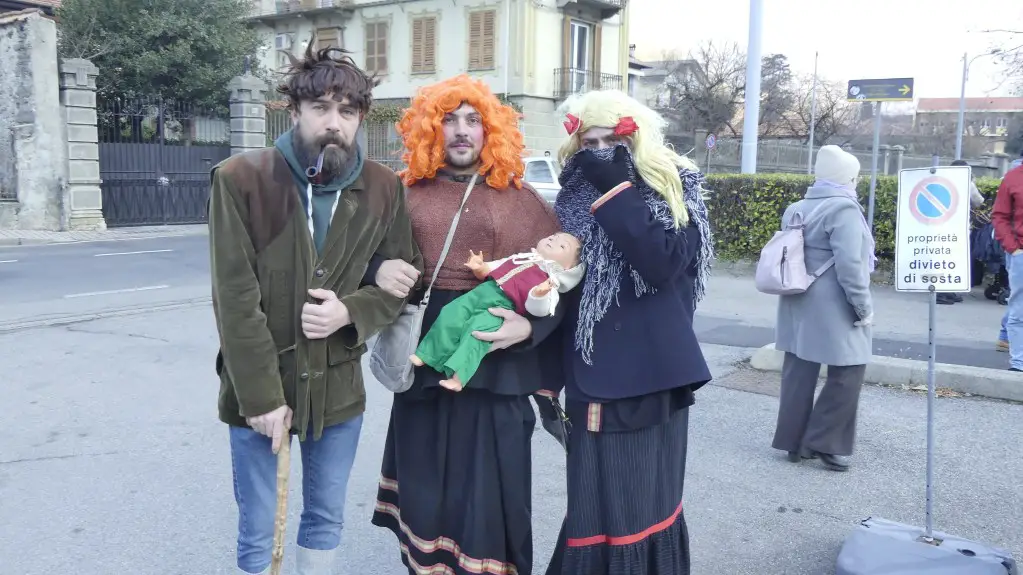
The Varallo rite on the day of the Epiphany (unique in Valsesia, but similar to traditions present elsewhere in northern Italy, for example in Colloro and Premosello Chiovenda both in the province of Verbania) opens in the morning with the welcome of the guest folk groups , usually the Flag-wavers of the Frontal of Asti, who perform in the square in front of the parish church. In the early afternoon the masked groups of the valley gather at the westernmost borders of Varallo Vecchio, the district located to the west of the Mastallone stream; the only group to never be present at this first phase is that of Varallo Nuovo, east of the Mastallone. Upon the arrival of the musical band, the procession begins, in which people both in masks and not participate and accompanied by a very modest allegorical float from which the boys of the Varallo Vecchio Carnival Committee distribute the Testament of the Veggia, a satirical poem, in exchange for a donation. in Valsesian dialect. The procession stops at several points to allow performances by the guest groups.
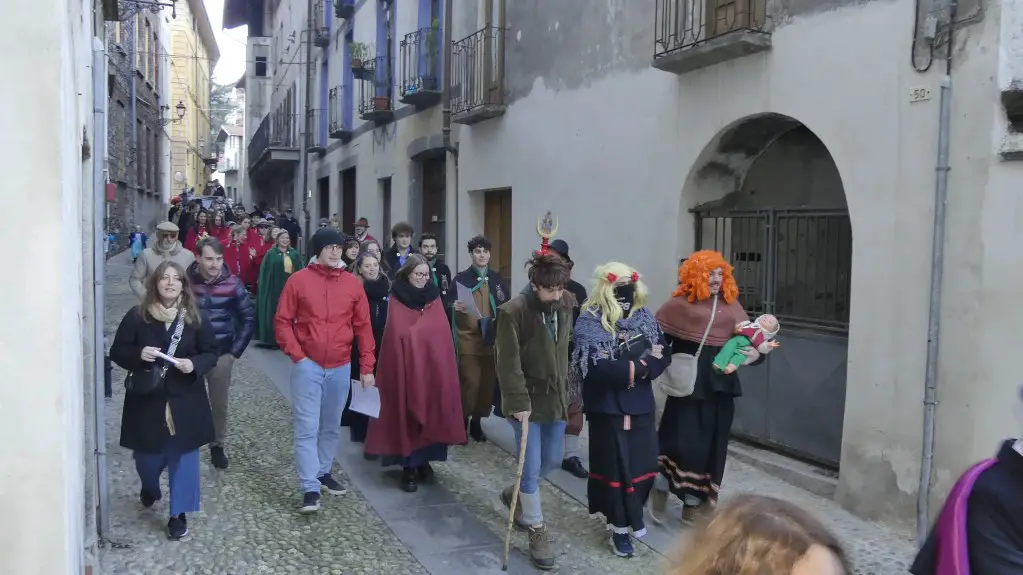
The tone of the demonstration changes when the procession crosses the bridge over the Mastallone and enters the territory of Varallo Nuovo: the guards of Varallo Nuovo intervene and have the task of capturing Veggia and putting her on trial on the accusation of having been unfaithful to the Veggiu Bacuc and having conceived Marcantonio illegitimately. La See for his part he stages one daring escape during which she can enter private homes, steal scooters or bicycles, interact with spectators calling for help with loud screams and even break into the churchyard of the parish church, all while the breathless guards are forced to chase her on foot. The spectacular and very eventful scene ends in any case with the capture of Veggia, who, finally revealed, is forcibly dragged to the square where the chamberlain of Varallo Nuovo reads the sentence condemning her to the stake. Assisting him are some characters in executioner costumes, i Brothers of the Good Death: last parodic echo of a religious brotherhood actually present in Varallo in past centuries, linked to the now no longer existing church of Santa Marta, which among its various tasks had that of offering spiritual assistance to those condemned to death.
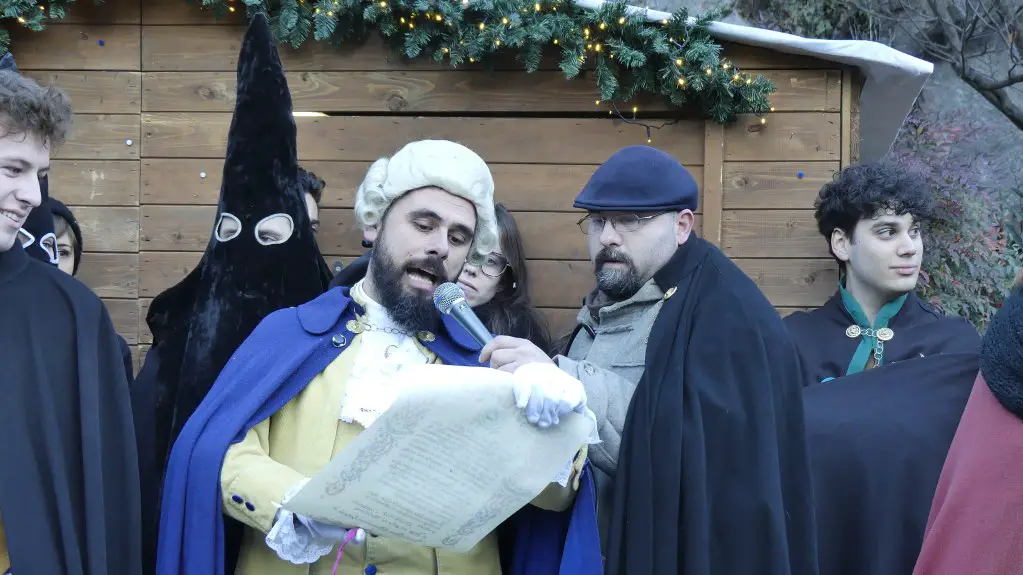
After a stop at some bars and clubs in the center to wait for darkness, the procession retraces its steps towards the bridge over the Mastallone, while the participants (masked or not) shout stentorian shouts such as "to death!", "to the stake!", "burn the Old Woman!", "burn, burn!" and similar; moving away from the square, the formal farewell of the guest groups takes place, which by tradition do not participate in the final moment of the rite. Before arriving on the bridge, Veggia can still attempt short escapes from the guards, often in taverns where she and her captors are offered drinks. Finally the sacrificial victim (because that is in fact what it is) is taken to the riverbed and burned at the stake, obviously replaced at the last minute by a puppet full of gunpowder and firecrackers. Spectators watch the evocative scene from the parapets of the bridge, while the musical band plays cheerful tunes with an increasingly pressing rhythm.
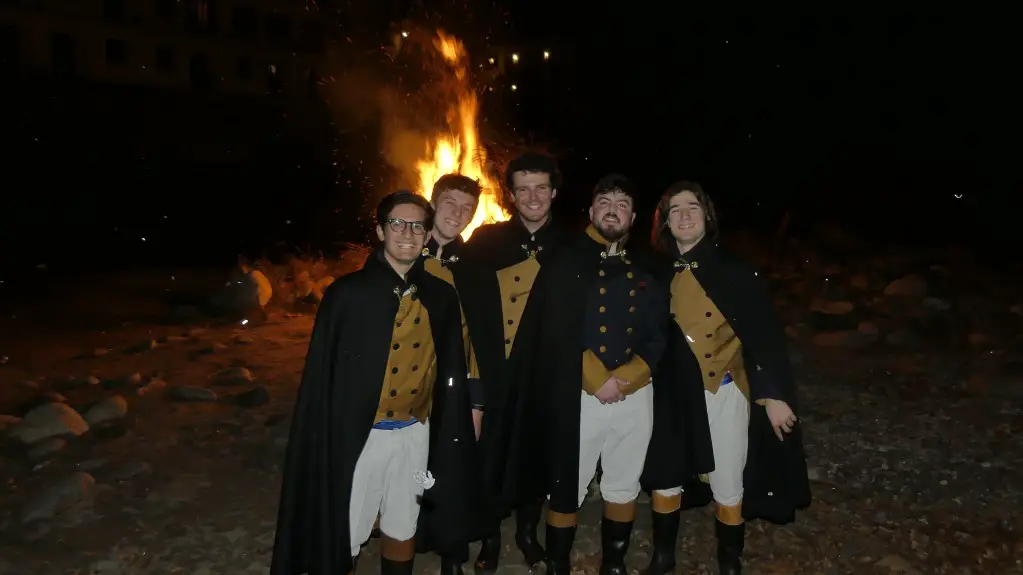
TIMELESS RHYTHMS
One of the best-known techniques for inducing the phenomena of alteration (but it would perhaps be better to speak of "amplification") of consciousness is that of implementing a deliberate modification of the rhythms of one's body, of one's internal "time", for example by inverting the perception of the day-night cycle: in the ritual moments that we have taken into consideration, man appropriates a time that does not belong to him, that of very rigid winter night in the mountains populated by spirits and dark powers, and transforms it into a fictitious "day" fueled by the sacrifice of a ritual victim, where large fires are lit and people dance continuously until the first light of dawn. It was also noted that the Sampeyre carnival event follows a double calendar; the starting date, Epiphany, is regulated by the solar calendar, while the mobile dates of the processions are calculated on the basis of the lunar calendar: the first parade of the militias takes place on the third to last Sunday before the start of Lent, with the full Moon , while the other two occur with the waning Moon, accentuating the dynamics of exploration of the darkness of the night when it is strongest and of the oppositional rhythm between light and darkness.
Always with a view to altering one's internal rhythm, he returns participation in processions and parades. In this particular context the mountaineer is forced to stop the long stride that is typical of him and adjust his pace to a shorter and more cadenced rhythm, regulated by the sound of the drums and musical instruments that accompany the parade and interrupted by numerous stops: the operation requires a semi-conscious effort and accentuates the sensation of entering a different "world", inverted compared to that of one's daily life.

Speaking of "inversions" we cannot fail to mention one of the most typical ones of the carnival, the inversion between man and woman. In Sampeyre and to a lesser extent in Varallo, once a year the male has the opportunity to wear women's clothes, which he is clearly not used to and which require a certain amount of practice to wear (just think of the possible obstacle that can represent a skirt for those who have always worn trousers). The fabrics with which women's clothes are made are also often qualitatively different from the usual men's clothes; for example, the sensation of a bonnet adorned with lace on the head or a silk shirt on the skin, for those who normally wear the roughest fabrics suitable for mountain work, is such as to alter the kinesthetic perception of one's body. This counter-rhythm does not only involve the clothes but in certain cases also the ritual objects that are used during the events: the axes of the sapeurs of Sampeyre, a work tool with which the mountaineer is certainly familiar, have the handle wrapped in delicate ribbons of silk so that holding them represents a totally different experience from normal.
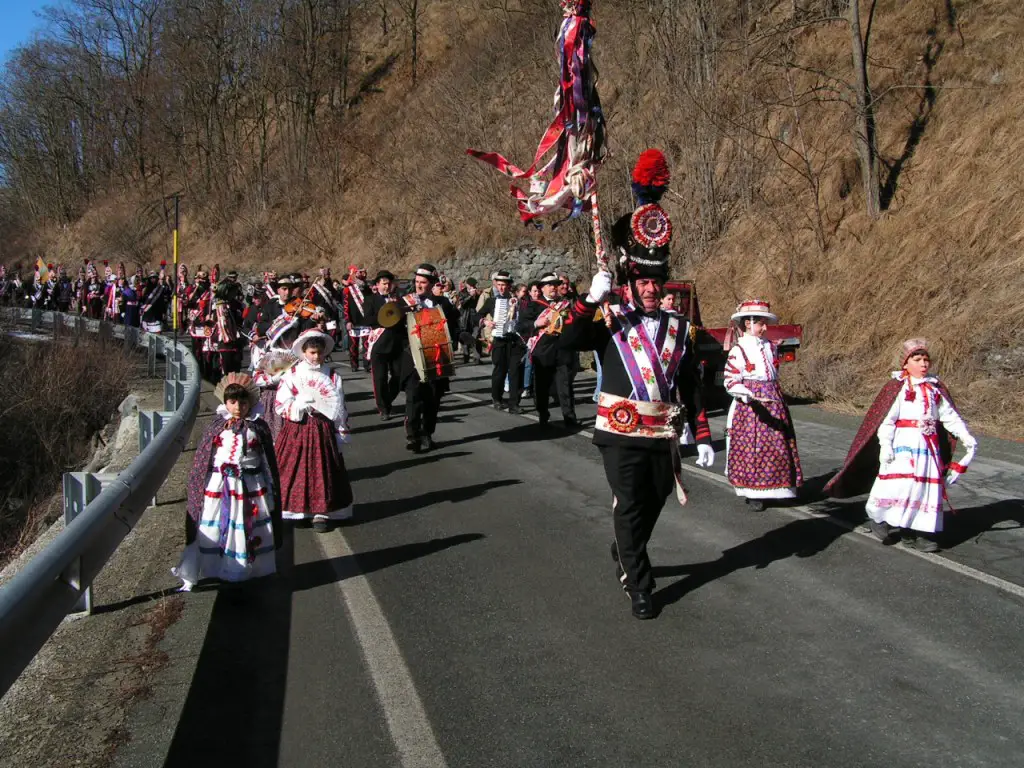
THE BATTLE OF LIFE AND DEATH
It was seen as the weather carnivalesque often takes on the dynamics of a conflict between opposing forces, which naturally also translates on the level of physical action. The entire ritual complex of Bahio of Sampeyre starts from a war event: by staging the defeat and expulsion of the Saracens, the villagers have the opportunity to physically take to the field and wage war against the unleashed forces of darkness and death, which are thus exorcised way. In Varallo the theme of conflict has been gradually weakened over time: historical evidence in fact tells us that the original ritual involved the lighting of not one but two bonfires on the two banks of the Mastallone stream, one for Varallo Vecchio and one for Varallo Nuovo, in a competition that often degenerated into a real brawl in which stones and beat. This rivalry is also represented in the contrast between the "totemic" animals with which the residents of the two districts identify: i dughi (owls) of Varallo Vecchio ei falcheit (hawks) of Varallo Nuovo, which offers yet another fascinating example of the contrast between night and day, light and darkness as well as a didactic description of the characters and attributes typical of the two districts: atavistic wisdom, loyalty to traditions but also stubbornness and fear of innovations for Varallo Vecchio, resourcefulness, foresight but also irreverence and lack of respect for Varallo Nuovo. Today the people of Varallo mostly limit themselves to emotional participation in the conflict between the two historic districts of the city represented by the escape and capture of the Veggia (coming from the farthest borders of Varallo Vecchio) by the guards of Varallo Nuovo, as well as witnessing the demonstrations of skill and physical agility proposed by the flag-wavers of Asti or by other guest groups. It must be added, however, that the involvement of the participants in the events is accentuated as the Varallo carnival progresses: for example on the evening of Carnevalàa n'tla stràa (Carnival in the street, often but not always coinciding with the patronal feast of San Gaudenzio) ends with a merry-go-round around a fire lit in the square, a very energetic merry-go-round in which the bulk of the fun consists in being violently yanked by the arms. At the end of the king dance Marcantonio Carlavèe (this time an adult and played by a real actor) invites us to remember our deceased and the people who have contributed to maintaining the carnival tradition through the centuries, and those present burst into cathartic tears.

“HERE TIME BECOMES SPACE”
If carnival involves a qualitative change in the way time is experienced, the same can be said of space. Indeed, from another point of view one could say that time itself takes on the qualitative nature of a space transfigured by ritual, as the Grail Knight Gurnemanz says in the famous “Parsifal” by Wagner: «Du siehst mein Sohn, zum Raum wird hier die Zeit», «You see, my son, here time becomes space».
That the breaking down or overcoming of a barrier is linked to concepts of renewal and fertility is such an integral part of our culture that we almost no longer notice it: let's just think of the ribbon cutting ceremony when an exhibition or a new building is inaugurated, or the act of forcing two newlyweds to cut a thick tree trunk with a blunt saw as is traditional in certain Piedmontese weddings; but the extraordinary antiquity of this concept is demonstrated, in cultures very distant from us, by the existence of particular mythical figures linked to winter, such as the snake Vṛtra of the Indo-Buddhist tradition who is killed to "free the waters" to which he is blocking causing drought. In the mountain villages the heavy snowfalls of the past often prevented free movement and limited the spaces for social interaction, so it is not a big surprise to see how in the Sampeyre carnival ritual, linked to the theme of the return of spring, there is more and more the breaking down of barriers has been repeated several times, not without violent physical involvement and a demonstration of virile power on the part of the actors. Even the exchange of military greetings between the hierarchs of the various militias, which takes place on the border between the concentric area and the hamlets, has great weight from this point of view: the participants physically mark the borders of their own territories, which do not always coincide with the current administrative borders of the specific areas, participating in the mythical narrative of a military parade, and the geographical limits themselves acquire a metaphysical weight in the process through which the members of the communities mentally create (or recreate) the space in which their daily life will take place after the carnival.
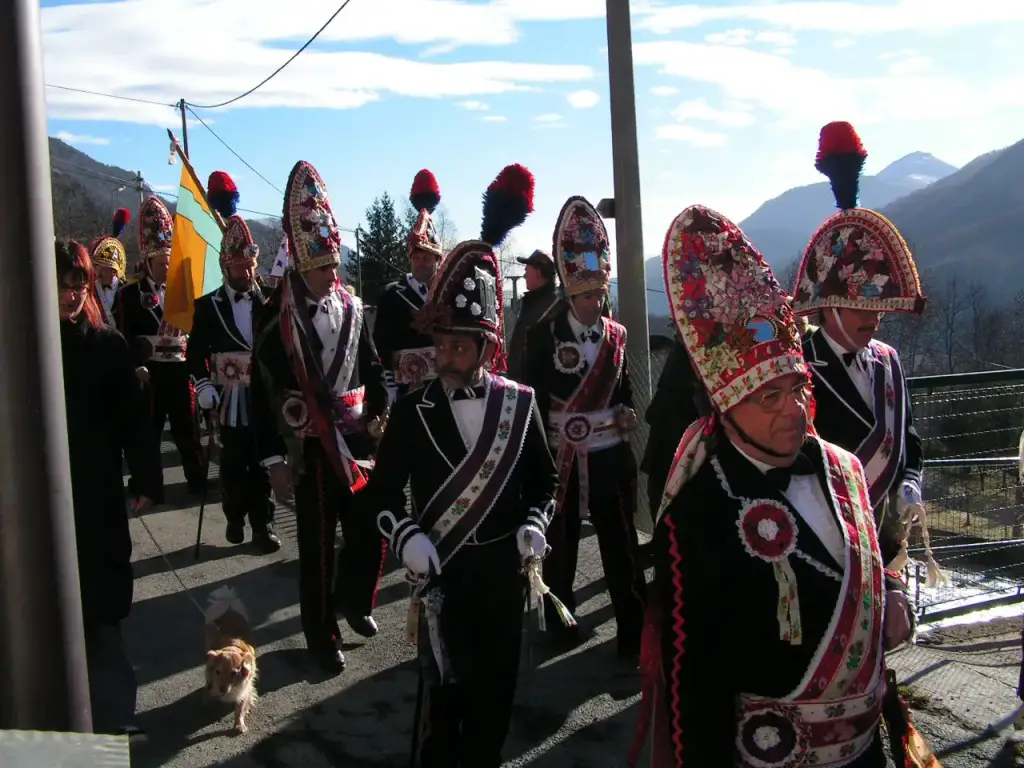
The barrier between the two districts of Varallo, as we have already seen, is the Mastallone stream, which is crossed by the Veggia Pasquetta parade and marks the passage between the first and second phase of the rite; but it also plays the role of the center of the world, of the place of origins of the Varallo community, since the town of Varallo historically developed from here, that is, around the ancient ferry, now replaced by a bridge, which connected the two banks of the stream. Here Varallo was born and here Varallo is reborn every year with the burning of the See you Easter Monday which marks the beginning of Carnival; here, moreover, the son of the woman will always die at the stake See Easter Monday, King Marcantonio Carlavèe, when the carnival has reached its natural conclusion, closing the cycle in the same way. This return to the origins takes place through both a symbolic and physical itinerary that the participants follow throughout the day, and was probably once also indicated by visual references and suggestions whose meaning today we struggle to immediately grasp. It seems difficult to attribute to chance, for example, the presence of a clock with the effigy of Saturn right on one of the ancient noble palaces that overlook this place so full of mythical and symbolic meanings: Saturn, king of the Golden Age when time did not yet exist, king of the future era when time will stop and the world will be reabsorbed back to the trans-spatial and trans-temporal point from which it originated.
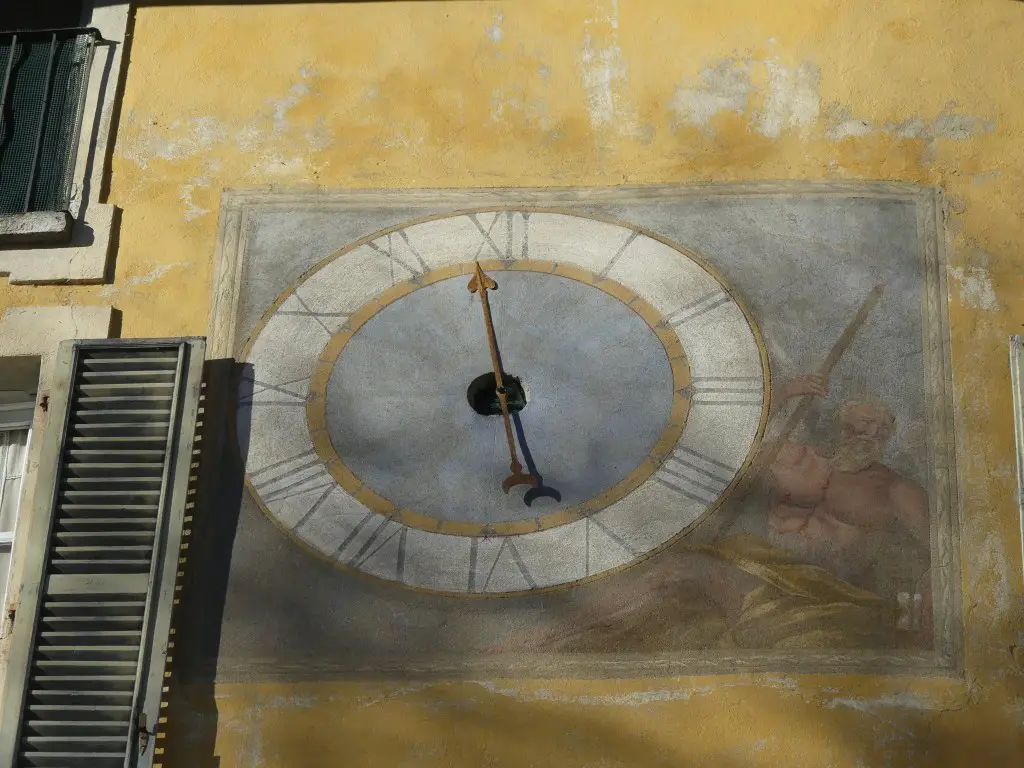
Linked to the prospect of retracing the ordinary course of time in space, but not to overcoming it in an eschatological key, it is instead a much later moment than the Varallo carnival, la Giurnaa d'la leugna (wood day) on the eve of Shrove Tuesday. Another carnival procession leaves the city and goes to the territory of the hamlet of Crevola, which was once located beyond the border with France; here the king of the Crevolese carnival, Carcarugu (onomatopoeic name indicating the rooster, one of the symbols of France) pays the people of Varallo a tribute in the form of pieces of firewood, which the following day will be used to prepare paniccia (a vegetable minestrone) distributed free of charge to the population. The tribute would have been imposed in exchange for the permission of the inhabitants of Crevola, by the municipality of Varallo, to use the ancient toll bridge that connected the concentric area to the hamlet. In essence we are faced with a carnival begging in which elements linked to local history and politics interfere, elements which are dramatized and, so to speak, consecrated in the collective memory through the ritual. The parade, incidentally, is preceded by one of the oldest ritual objects of the Varallo carnival, the Marcantoniu of salaim (Marcantonio dei salami), grotesque wooden effigy adorned with salami dating back to 1885. Someone wanted to see the blasphemous imitation of a crucifix, almost as if the parade of the Giurnaa d'la leugna was originally intended as parody of the religious rogations that were made along the banks of the Mastallone and the Sesia river, which separates Varallo from Crevola, to avoid floods and droughts and to obtain a good harvest.
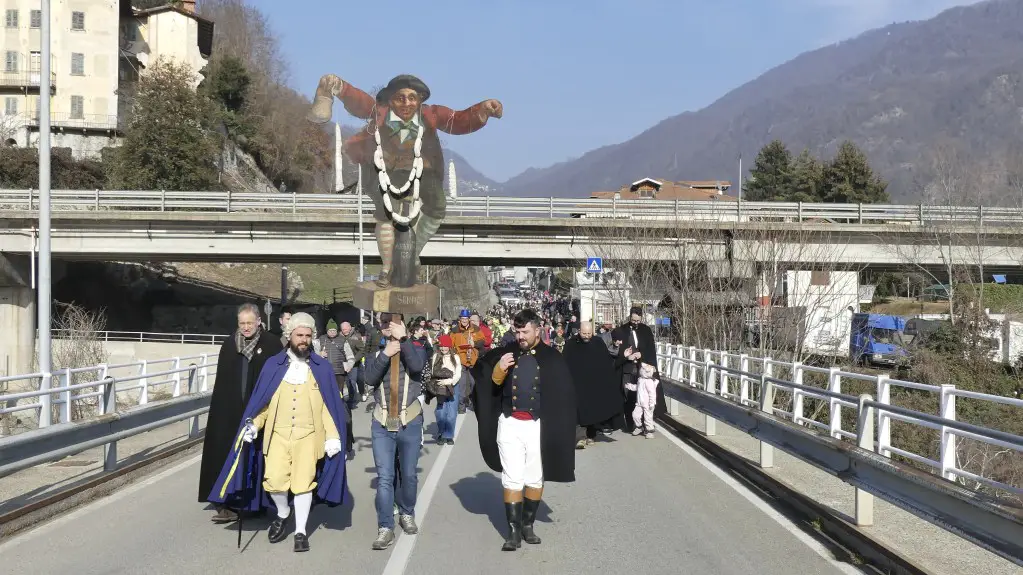
“DO NOT SEARCH FOR EXPLANATIONS”
Investigating what the carnival experience represents for the individual is, as has already been said, particularly difficult. The inversion of the perceptions and physiological rhythms of the body, the whirling dance, the physical competition, the circumambulations of a sacralized space, the replacement of identity through the use of masks are notoriously tools used in cultural traditions throughout the world. world, capable of inducing more or less profound states of alteration of consciousness; but any attempt to understand what this could mean exactly for the person who in that particular moment experiences this condition must deal with one of the most recurrent characteristics of the experience itself, namely its partial or total ineffability. The researcher who asks the fateful question "what does it feel like to go to carnival?" often comes up against the refusal or claimed inability to describe the experience verbally. “It can't be explained”, “it can't be said”, “it's indescribable”, “there are no words” are among the most common answers you can receive; or, as a popular song celebrating the Varallo carnival says, “don't look for explanations”.
Nonetheless, at least in vague glimmers, it is perhaps possible to say something. The New Year rites that we have taken into consideration are complex and redundant semantic objects that materialize the collective narrative of the myth, through which the countless human generations have represented themselves in relation to the universe that surrounded them; And participating means opening oneself to the possibility of experiences which, even if for socio-cultural reasons they are no longer recognized as such, definitely have a mystical value. The carnival actor does not wear the costume and the mask, he "becomes" the costume and the mask: his usual personality, linked to everyday life, takes a back seat, for him ordinary space and time are suspended and in particular moments of the year he has the possibility of moving in the same world of the Gods and the Ancestors, of the divine syzygies and of the processions of the rural spirits.
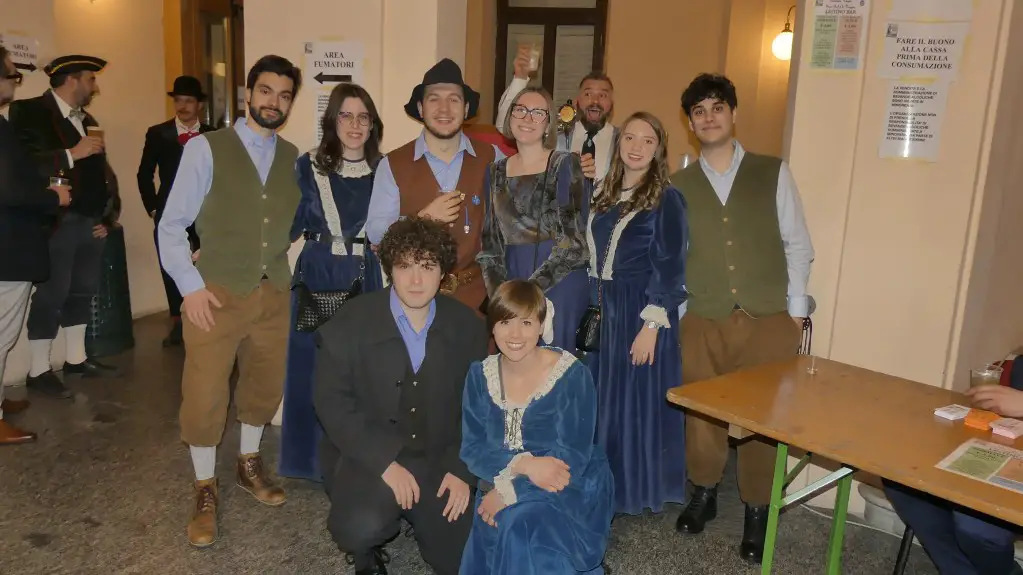
Of course, this positive outcome is not always possible, because the man with the mask always runs on a razor's edge: if his personality wanted to maintain control at all costs, the ritual would become the boring and insipid reiteration of a custom which is not he understands the meaning more, if he were to withdraw completely he would fall into the unawareness of orgiastic excess, into the animalistic ranting of the drunk. Those who are fortunate enough to possess the particular psychic constitution to maintain a dynamic balance between these two extremes instead it talks about very peculiar experiences, sometimes vaguely described as a "lucid intoxication", during which the world is transfigured into a living alphabet in which everything is rich in new meanings and there is an invigorating sensation of joy, integration and well-being that sometimes it can result in important insights about oneself, one's life, one's role in the world and in society.
The short-sightedness of the research which we mentioned at the beginning of this intervention, which prefers to ignore these aspects of the carnival experience to concentrate on the mere philological and material data, can lead and has in fact led in the past to several missteps, and not only on the purely academic. Let us think of those cases in which the very laudable attempts by scholars and university professors to restore historical carnivals that have disappeared for several decades have given very unsatisfactory results: in the best of cases pantomimes with great visual effect, but which retain little or nothing of the authentic spirit and originally from the carnival. Too often overlooked by scholars, the direct and sometimes extraordinary experiences of those who experience carnival constitute its heart and reason for being: and if it is true that seeking explanations could ultimately be in vain, it is on the other hand not impossible to ignore these aspects if we really want to give, to the extent possible, a well-rounded picture of this fascinating tradition which is so deeply rooted in the mystery of our remote past as well as in the deepest essence of what makes us men. Only in this way can the carnival continue to be the bridge that unites the ancestral myths of the past with the reality of future generations.
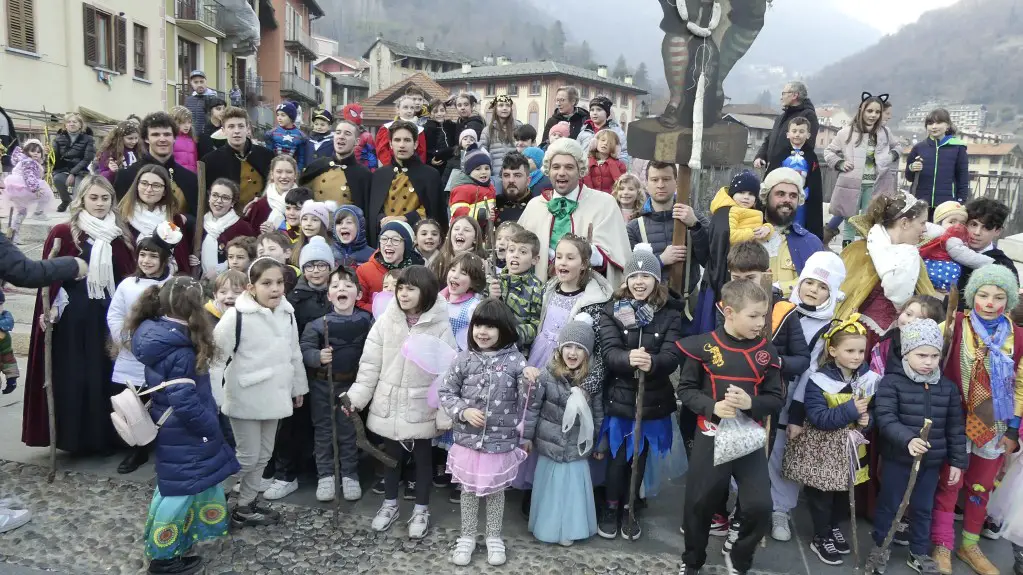
BIBLIOGRAPHY
Barbano, Enzo: Confetti ash, Valsesia publishing 1983
Centini, Massimo: Basure, Masks and strange creatures, Coedit 2017
Centini, Massimo: On the trail of the Wild Man, Magenes editorial 2018
Gallo Pecca, Luciano: The masks, the carnival and the celebrations for the arrival of spring in Piedmont and the Aosta Valley, Giribaudo 1987
Grimaldi, Piercarlo: Fat times, lean times, Omega editions 1996
